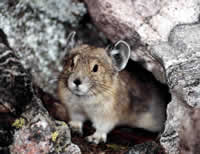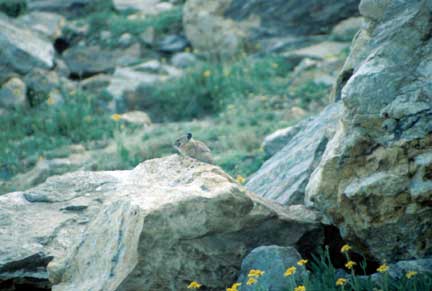Persistence of pikas in two low-elevation national monuments in the western United States
 |
Introdution
Although national
parks act as island reserves for animals and plants, recent research has
highlighted the dramatic
changes (e.g., local extirpations, invasions of exotic species) that can
occur in flora and fauna even on lands where the primary management mandate
is resource conservation (Svejcar and Tausch 1991, Newmark 1995). The legacy
of past disturbances, influences from adjacent lands, and climate change,
in addition to the isolation and relatively small size of park units may
all affect persistence of species within parks. In the western United States,
pikas (Ochotona princeps) represent a model system that may help ecologists
to understand these timely and complex relationships, as well as their implications
for management in at least two units of the National Park System.
"pikas
may be early sentinels of biological response to global climate
change such as increased
temperatures"
|

Figure 1. Often heard but not seen, pikas typically inhabit high-elevation talus slopes in the western United States. However, the unusual occurrence of low-elevation pika populations in two western U.S. national monuments prompted the author to investigate their persistence and to evaluate implications for management of the species.
Figure 2. Pika surveys took place at 25 locations in the internally drained (interior) Great Basin; at Craters of the Moon and Lava Beds National Monuments where low-elevation populations of pikas persist; and at Hell’s Half Acre, a low-elevation site near the monuments that lacks pikas but has similar habitat.
In the Great
Basin (where precipitation drains internally rather than to an ocean;
fig.
2), persistence of pika populations during the 20th
century was significantly correlated with habitat area, elevation, longitude,
distance to primary roads, latitude, grazing status, and management jurisdiction
(wilderness vs. non-wilderness), but not with isolation of populations
from the Sierra Nevada or Rocky Mountains (Beever 1999). Island biogeography
theory predicts greater rates of extinction on islands (which may be
oceanic or island-like pockets within continents) that are smaller in
area and more isolated from the mainland, but does not make direct predictions
about the other factors. Thus, the fact that isolation from Sierra Nevada
or Rocky Mountain “mainlands” is not important in pika extirpations
suggests that migration of pikas between mountaintop islands is not occurring
currently. Rather, it appears that extirpation of populations from montane
areas across the Great Basin is occurring without any concomitant colonization
events. Average temperatures generally decrease with increasing latitude
and elevation, thus latitude must be accounted for when assessing persistence
at different elevations.
Continued
Next Page
Our Founder Questions? Go to About Our New Site |
Masthead
Photo from: |